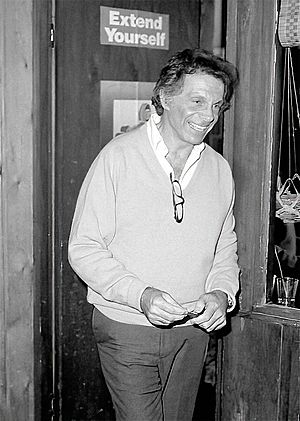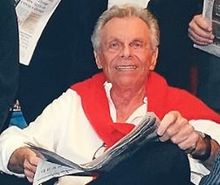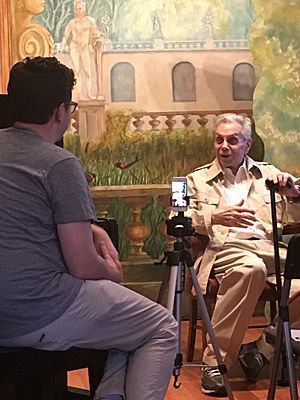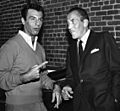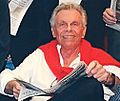Mort Sahl facts for kids
Quick facts for kids Mort Sahl |
|
|---|---|
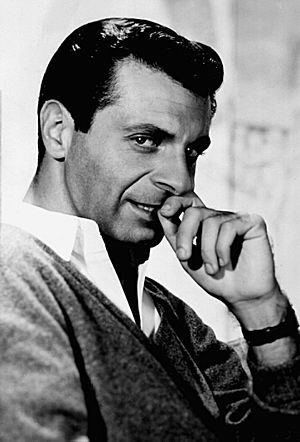
Sahl in 1960
|
|
| Birth name | Morton Lyon Sahl |
| Born | May 11, 1927 Montreal, Quebec, Canada |
| Died | October 26, 2021 (aged 94) Mill Valley, California, U.S. |
| Medium | Stand-up, television |
| Nationality | American |
| Alma mater | University of Southern California |
| Genres | Political satire, improvisational comedy |
| Subject(s) | American politics, American culture |
| Spouse |
|
Morton Lyon Sahl (May 11, 1927 – October 26, 2021) was a comedian, actor, and social satirist. He was born in Canada but became an American citizen. Many people see him as the first modern comedian. Mort Sahl created a new type of comedy. He would make fun of politics and news using jokes he made up on the spot. His only prop was usually a newspaper.
Sahl spent his early years in Los Angeles. He then moved to the San Francisco Bay Area. There, he started his professional stage career in 1953. This was at the hungry i nightclub. He quickly became popular. After a year, he traveled across the country. He performed at famous nightclubs, theaters, and colleges.
In 1960, Time magazine featured him on its cover. He was the first comedian to get this honor. He also appeared on many TV shows. He acted in several movies. He even had a one-man show on Broadway.
Television host Steve Allen called Sahl "the only real political philosopher we have in modern comedy." His comedy shows were new and exciting. A stand-up comic talking about real-world politics was seen as "revolutionary." He inspired many comedians who came after him. These included Lenny Bruce, Jonathan Winters, George Carlin, Richard Pryor, Lewis Black, and Woody Allen. Woody Allen said Sahl's new humor style "opened up vistas for people like me."
Many politicians liked his work. John F. Kennedy even asked him to write jokes for his speeches. However, Sahl later joked about the president too. After Kennedy's assassination in 1963, Sahl focused on questions about the official report. He talked about this often in his shows. This made some of his audience leave. His popularity went down for the rest of the 1960s. By the 1970s, his shows and popularity started to come back. This continued for many years. A book about Sahl, Last Man Standing, came out in 2017.
Contents
Mort Sahl's Early Life and Education
Mort Sahl was born on May 11, 1927. This was in Montreal, Quebec, Canada. He was the only child of Jewish parents. His father, Harry Sahl, came from an immigrant family in New York City. He wanted to be a Broadway writer. Harry met his wife, Dorothy, through a poetry magazine ad. They moved to Canada when he could not become a writer. There, he owned a tobacco store.
Sahl's family later moved to Los Angeles, California. His father could not become a Hollywood writer. He worked as a clerk and court reporter for the FBI. Sahl said, "My dad was disappointed in his dreams." Sahl went to Belmont High School in Los Angeles. He wrote for the school's newspaper. Actor Richard Crenna was a classmate.
When the U.S. entered World War II, Sahl was 14. He joined the school's Reserve Officers' Training Corps (ROTC). He won a medal for marksmanship. He also won an American Legion "Americanism award." He wanted to show his patriotism. He wore his ROTC uniform to school and in public. When he turned 15, he quit high school. He joined the United States Army by lying about his age. His mother found him and brought him home two weeks later. She had told them his real age.
After high school, his father tried to get him into West Point. His Congressman helped. But Sahl had already joined the United States Army Air Forces. He was sent to Alaska with the 93rd Air Depot Group. In the military, he did not like the strict rules. He grew a beard and did not wear a cap. He also wrote articles for a small newspaper criticizing the military. This led to him being punished with three months of KP duty. Sahl later said his military experience was "spiritual" and good.
Sahl left the military in 1947. He went to Compton College. Then he went to the University of Southern California. He earned a degree in 1950. His majors were traffic engineering and city management. He started a master's program. But he quit to become an actor and playwright.
Mort Sahl's Comedy Career
Starting in Comedy
Between 1950 and 1953, Sahl tried to get jobs as a stand-up comedian. He tried about 30 nightclubs in Los Angeles. But he had no success. NBC once told him he would never be a comedian. He even offered to perform for free during intermissions. He just wanted a chance to show his talent. He remembered that time: "My friends constantly discouraged me." He and a friend then rented an old theater. They called it Theater X, for "experimental." He began writing and staging one-act plays. One play was called Nobody Trusted the Truth. They could not attract enough people. So they closed the theater.
For money, Sahl did odd jobs and wrote. He sold used cars and was a messenger. He wrote a novel that was not published. He also wrote short stories. He went to New York hoping to sell his plays. But he only made about eighteen dollars a week. He recalled, "I couldn't get a thing going." He decided to try something different. He would perform his plays as monologues. He felt it would be easier to do his monologue on stage. "I knew that if I was going to get anything done, I'd have to do it myself," he said. He returned to Los Angeles. He appeared at some clubs. But his new style of monologue comedy got little attention.
In 1953, he started dating Sue Babior. She moved to Berkeley to study. This was at the University of California. Sahl hitchhiked there to be with her. He spent his time attending classes without enrolling. He also hung out at local coffee houses. For money, he wrote for some avant-garde magazines. He slept in the back seat of a friend's car. Babior was living with roommates. "Things were simple then," he said. "All we had to worry about was the destiny of man." He felt at home in the San Francisco Bay Area. He commented, "I was 'born' in San Francisco." He said his three years in Berkeley were very valuable.
Sahl looked for clubs where he could perform stand-up. Babior suggested he try out for the hungry i. This was a nightclub in San Francisco. The owner, Enrico Banducci, liked Sahl's comedy right away. He offered him a job for $75 a week. This was about $720 in 2020 money. It became his first steady job as a stand-up comedian.
News about Sahl's comedy spread fast. He got good reviews from newspaper columnist Herb Caen. This gave him instant fame. "I don't know where Mr. Sahl came from but I'm glad he's here," Caen wrote. Caen invited his friends, like Danny Kaye and Eddie Cantor, to see Sahl. Cantor helped him and gave him ideas. By the end of his first year, Sahl was earning $3,000 a week. This was about $29,000 in 2020 money. He performed to full houses. Later, he said, "I'd be washing cars if it weren't for Enrico."
Nightclub Shows and National Fame
After a year at the hungry i, Sahl began performing across the country. He played at clubs like the Black Orchid in Chicago. He also performed at the Crescendo in Los Angeles. In New York City, he played at the Village Vanguard. Many clubs had never had a stand-up comedian before. Sahl had to create his own places to perform. "I had to build up my own network of places to play," he said.
Many famous people came to see his shows. They heard about the "new phenomenon." This referred to Sahl's unique comedy style. Woody Allen saw his show in 1954. He said Sahl "was suddenly this great genius that appeared who revolutionized the medium." British comedy actor John Cleese was very interested in Sahl's humor. He respected Sahl as much as The Beatles respected Elvis Presley.
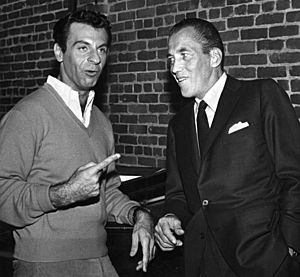
Television host Steve Allen started the Tonight Show. He said he was "struck by how amateur he seemed." But he meant it as a compliment. He noted that old comics dressed formally. They were smooth and well-rehearsed. They always controlled their audience. Allen said Sahl's "very un-show business manner was one of the things I liked."
Sahl dressed casually. He wore no tie and often a V-neck sweater. His stage presence was seen as "candid and cool." He was the opposite of a slick comic. This was noted by theater critic Gerald Nachman. Sahl was known as an intellectual comedian. But he disliked this image. "It was absurd. I was barely a C student," he said. His natural style on stage was because he liked to make up jokes on the spot. He did not carefully rehearse his monologues.
His casual stand-up style influenced new comedians. These included Lenny Bruce and Dick Gregory. Sahl was less controversial. He looked "collegiate" and focused on politics. Bruce talked about language. Gregory focused on the civil rights movement. After seeing Mort Sahl, Woody Allen decided to try talking about his personal life. "I'd never had the nerve to talk about it before," Allen said. "Then Mort Sahl came along with a whole new style of humor."
Nachman described Sahl as a "gifted narrator." He was so good at taking you along on his stories. You did not realize until the show was over that you had been on a long journey. Sahl's fast monologues were also special. British film critic Penelope Gilliatt said Sahl's jokes went on a "breakneck stammering loop." She thought it would never make sense. But it always did. For her, it was like watching a circus act.
Sahl's popularity "mushroomed like an Atomic cloud during the 50s," said filmmaker Robert B. Weide. He added, "Simply put, Mort Sahl reinvented stand-up comedy." Time magazine put him on its cover in 1960. They called him "the best of the New Comedians." They also said he was "the first notable American political satirist since Will Rogers." Besides clubs, he appeared in films and on TV shows. His network debut was on The NBC Comedy Hour in May 1956. He was also a temporary host on The Tonight Show. This was after Jack Paar left and before Johnny Carson started.
His audience grew wider. It included students and "hip" people. Now, even famous politicians came to his shows. Some became friends. Presidential candidate John F. Kennedy was one. He asked Sahl to prepare political jokes for his speeches. Kennedy liked Sahl's style of political humor. He liked Sahl's "relentless pursuit of everybody." Adlai Stevenson and Hubert Humphrey were fans. Humphrey said, "whenever there is a political bloat, Mort sticks a pin in it." Sahl considered Ronald Reagan one of his closest friends.
They valued that he stayed current. He took material from major newspapers and magazines. He kept his jokes fresh. He wrote few notes. He entertained audiences by presenting serious news with humor. He did not like television news in 1960. He blamed it for "spoon-feeding" the public. He said it caused "corruption and ignorance."
Because of Sahl's popularity, he achieved many firsts. He was the first comedian on the cover of Time. He was the first to make a record album. He was the first to do college concerts. And he was the first comedian to win a Grammy.
Later Career and Comeback
After Kennedy's assassination in 1963, Sahl became very interested in who was responsible. He even became a special helper for New Orleans District Attorney Jim Garrison. Garrison was investigating the assassination. As a result, Sahl's comedy often talked about his political views. He would read and comment on the official report. He often questioned its accuracy. This made many of his audience members leave. He was also blacklisted by some. More of his planned shows were cancelled. His income dropped from $1 million to $13,000 by 1964. According to Nachman, focusing too much on the assassination details hurt Sahl's career. Sahl later said, "there's never been anything that had a stronger impact on my life than this issue." But he still thought it was a "wonderful quest."
By the 1970s, the rise of counterculture helped Sahl's comeback. He was seen alongside new comedians. These included George Carlin, Lily Tomlin, and Richard Pryor. In the 1980s, he performed at Banducci's new clubs in San Francisco. In the late 1980s, he tried to write screenplays. He also did shows around the country. In 1987, he had a successful run in Australia.
In 1988, Sahl was back in New York City. He performed a one-man Off-Broadway show. It was called Mort Sahl's America. Critics gave it good reviews. But it did not sell many tickets. The New York Times said, "History has returned Mort Sahl to the spotlight when he is most needed." Robert Weide made a documentary about him. It was called Mort Sahl: The Loyal Opposition. It aired on PBS in 1989.
Sahl found it harder to get back to his earlier level of success. One Los Angeles Times critic wrote, "Sahl is a man with a country but not a stage." Some TV specials gave him a chance to perform live. Starting in November 1991, the Monitor Channel aired eight shows called Mort Sahl Live.
From the 1990s on, he performed less often. He mostly played in theaters and college auditoriums. Woody Allen saw him perform in 2001. It was one of his rare New York club appearances. Allen told him, "this is crazy – you should be working all the time." Allen then called his manager Jack Rollins. Sahl then did shows at Joe's Pub in Manhattan. These shows were packed.
In 2008, Sahl performed at B.B. King's Blues Club & Grill. This was on 42nd Street. Woody Allen, Elaine May, and Dick Cavett were there.
Sahl was ranked #40 on Comedy Central's list. This was for the 100 greatest stand-up comedians. He was ranked between Billy Crystal and Jon Stewart. In 2003, he received the Fifth Annual Alan King Award. This was for American Jewish Humor. In 2011, the Library of Congress added his 1955 recording, At Sunset, to the National Recording Registry.
Mort Sahl's Satire Comedy Style
Sahl's humor was based on current events. He especially focused on politics. This led Milton Berle to call him "one of the greatest political satirists of all time." His famous style was to walk onto the stage with a newspaper. He was casually dressed in a V-neck sweater. He would often read news stories and add his jokes. Time magazine called him "Will Rogers with fangs" in 1960.
Sahl would talk about people or events. It was almost as if he was reporting them for the first time. He would then go into related stories or his own experiences. TV executive Roger Ailes said he saw Sahl read the paper one day. After a few hours, Sahl went on stage with a whole evening's new material. "With no writers, he just did what he had seen in the afternoon paper. He was a genius."
Sahl's news commentary as social satire attracted many famous fans. These included Adlai Stevenson, Marlene Dietrich, and Leonard Bernstein. Arthur M. Schlesinger, Jr. said his popularity was due to people wanting "youth, irreverence, trenchancy, satire." Steve Allen introduced him on one of his shows. He called Sahl "the only real political philosopher we have in modern comedy."
Sahl's ability to make up jokes on the spot was special. His naturalness was also unique for a stage performer. Woody Allen noted that other comics were jealous. They did not understand how Sahl could perform by just talking to the audience. Nachman said that a stand-up comic talking about the real world was "revolutionary." He added that the comedians who followed him were influenced by his style.
Mort Sahl's Personal Life
Sahl was married three times. He married Sue Babior in 1955. They divorced less than three years later. In the early 1960s, his steady girlfriend was Tippi Hedren.
In 1967, he married actress and model China Lee. They divorced in 1991. They had one son, Mort Sahl Jr. He died in 1996 at age 19.
In 1997, he married Kenslea Ann Motter. They divorced around 2009. He was sad about the end of their marriage. He said, "I'm sorry I divorced Kenslea; I'm still in love with my wife."
In 1976, Sahl wrote a book about his life. It was called Heartland.
In June 2007, many famous comedians honored Sahl. These included George Carlin and Jonathan Winters. They gave him an 80th birthday tribute.
In 2008, Sahl moved from Los Angeles to Mill Valley, California. This is near San Francisco. He became friends with comedian Robin Williams, who lived nearby.
Until the COVID-19 pandemic in 2020, Sahl worked every Thursday night. He would take questions from a live audience. He also took questions from Periscope/Twitter.
Sahl died of natural causes at his home in Mill Valley. This was on October 26, 2021. He was 94 years old.
Mort Sahl's Discography
Performance Albums
- At Sunset, Fantasy Records (recorded 1955, released 1958)
- The Future Lies Ahead, Verve Records (1958)
- Mort Sahl: 1960 or Look Forward in Anger, Verve Records MG V-15004 (1959)
- At the hungry i, Verve Records (1960)
- The Next President, Verve Records (1960)
- A Way of Life, Verve Records (1960)
- The New Frontier, Reprise Records (1961)
- On Relationships, Reprise Records (1961)
- Anyway... Onward, Mercury Records (1967)
- "Sing a Song of Watergate... Apocryphal of Lie!", GNP Crescendo Records (1973)
- Mort Sahl's America, Dove Audio (1996)
Compilation Album
- Great Moments of Comedy with Mort Sahl Verve Records (1965)
Mort Sahl's Selected Filmography
- In Love and War (1958) as Danny Krieger
- Richard Diamond, Private Detective (CBS-TV 1959) as Himself
- All the Young Men (1960) as Cpl. Crane
- Johnny Cool (1963) as Ben Morrow
- Doctor, You've Got to Be Kidding! (1967) as Dan Ruskin
- Don't Make Waves (1967) as Sam Lingonberry
- hungry i reunion (1981) as Himself, documentary
- Inside the Third Reich (1982) (TV) as Werner Finck
- Nothing Lasts Forever (1984) as Uncle Mort
- Jonathan Winters: On the Ledge (1987) as Himself, TV special
- Mort Sahl: The Loyal Opposition (1989) as Himself, American Masters documentary
- The World of Jewish Humor (1990) as Himself, documentary
- Looking for Lenny (2011) as Himself, documentary
- When Comedy Went to School (2013) as Himself, documentary
- Max Rose (2016) as Jack
Images for kids
See also
 In Spanish: Mort Sahl para niños
In Spanish: Mort Sahl para niños


